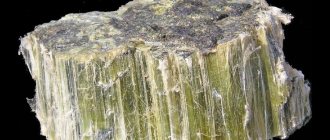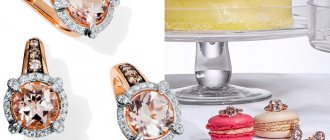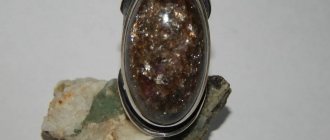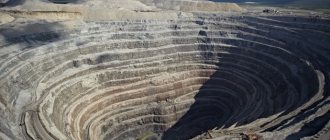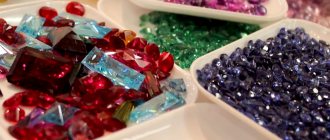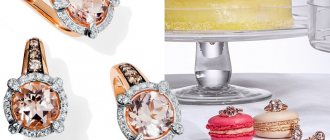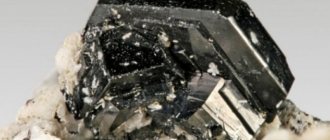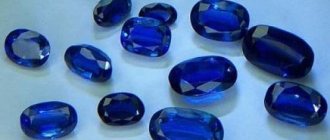Precious stones are rare minerals that have natural beauty, which in most cases manifests itself after jewelry processing. In addition to their amazing external shapes and colors, these minerals have exceptional durability and incredible strength. That is why they have a very high price, are placed in closed storage facilities and well-protected collections. And they are used as financial assets in banking.
- Cut
All forms and methods of legal regulation in this area are carried out on the basis of Federal Law No. 41-FZ of March 26, 1998 “On Precious Metals and Precious Stones”.
Main characteristics
Rarity
A quality that determines the frequency of occurrence of a mineral in nature. Precious stones possess it to the fullest. Some of them are so unique that they are found in one or several copies. However, this characteristic can easily change in one direction or another due to the discovery of new deposits, or vice versa - cessation of production due to depletion of deposits.
In this regard, carmeltazite is of particular interest - a stone that arrived on Earth from outer space. Also quite curious in this regard is the future development of mineral resources of nearby planets and asteroids, which may entail a change in the level of rarity of terrestrial gems.
Durability
It is this property of precious stones that allows them to remain unchanged for centuries. Durability is based on mechanical strength, determined by hardness, fragility, and resistance to mechanical, temperature and chemical influences.
beauty
The beauty of precious stones makes an indelible impression on any person. Thanks to it, value is formed, the desire to possess unique value is manifested and decorate it with skillful framing, creating unsurpassed jewelry. The concepts of beauty of precious stones include:
- color and reflective qualities,
- ability to take an elegant geometric shape,
- the ability to have a highly polished surface.
"Pearl of Gogibus" (126 carats)
Most likely, this is the largest pearl in Europe. It has an ancient history. In 1620, it was brought from the West Indies by François Gogibus. He offered to buy it to the Spanish King Philip IV. According to legend, when the monarch saw the pearl, he asked the merchant how he decided to invest his entire fortune in such a small item, to which he replied: “Because I knew that there was a king of Spain to buy it from me.”
The trace of the historical Gogibus pearl was lost, but the rarity reappeared on the market in 2010
Mining in mines, quarries and placers
The main methods of mining gemstones currently are:
- Washing in placers. Stones that have fallen to the surface of the earth under the influence of water currents are found by manually washing the soil or slag.
- Organization of an open pit. Involves excavation work, often with the use of explosions, the use of drilling rigs, heavy machinery, and special equipment. Direct methods for finding stones vary depending on the rock and size of the minerals.
- Mining. The most expensive and risky mining method, which is resorted to only if there is confidence in the presence of precious stones in the veins being mined.
To organize the extraction of minerals, mining enterprises are created, equipped with modern equipment and qualified personnel: copies, mines, mines. Although, private manual mining also takes place in a number of countries around the world.
Properties of transparent stones
Since the discovery of the first gems, people have endowed stones (including transparent ones) with magical properties, sincerely believing in their ability to influence human life and change the future. For a long time, the possession of crystals was perceived as the privilege of magicians and priests, who, with the help of stones, “looked” into the future.
People believed that amulets protected against evil spirits and the evil eye and believed that owning a talisman in the form of a transparent crystal would help avoid misfortunes in life. In addition, the stones were credited with the following abilities:
- protect peace and tranquility in the family;
- improve relationships with others;
- impart wisdom and prudence;
- ensure success in work and new endeavors;
- protect on the way;
- protect from envious people and ill-wishers.
In addition to magical effects, minerals are also credited with a healing effect on the human body.
Moreover, this property was considered characteristic not only of precious gems; semi-precious stones with strong energy also helped to get rid of a number of diseases. This is for example:
- problems with the stomach and digestion;
- heart and vascular diseases;
- high blood pressure;
- breathing and lung problems;
- eye diseases.
Types of processing
First of all, I would like to bring some clarity to the very concept of processing. The fact is that some experts by this term mean “refinement” of precious stones, which represents diffusion, impregnation and thermal effects. Excluding all types of mechanical impact.
Indeed, these methods significantly improve the color qualities of stones and increase their “longevity”. True, in this case the crystal lattice and the chemical composition of the mineral itself change significantly. With a purely mechanical effect, this does not happen, since it affects only the outer part of the stone.
Cut
The process of forming facets on the surface of a gemstone is called cutting.
Diamond
This type of cut is most used in diamond processing, although a number of other precious stones are also processed with its help. Its ultimate goal is to give the product a diamond shape. With the help of which complete internal light reflection is achieved. As a result, a beam of light is reflected twice from the opposite rear edges and exits the front part.
Diamonds have been cut this way for centuries. First single, and then double, triple, and also round brilliant cut. The process of creating new forms continues today, but in accordance with the requirements of the World Diamond Union and the Scandinavian Diamond Nomenclature.
Emerald
A rather rare cut, invented in the middle of the last millennium. It has more than 50 edges laid out in several rows. A stone processed in this way is shaped like an ancient multi-stage Aztec temple, albeit octagonal in shape with slightly beveled corners.
Mixed
The mixed shape combines smooth and faceted cuts. The stone becomes smooth on one side, and becomes covered with edges on the other. True, nowadays such a combination on one side of the finished jewelry is becoming increasingly popular.
Stepped
The beveled edges (facets) are located one above the other - in steps, resulting in a polygonal area. The side faces will be made in the form of trapezoids or isosceles triangles.
Briolette cut
Drop-shaped stones are often processed with the ancient briolette cut, which allows the gem to shine brightly with many (usually 56) triangular facets.
Pear cut
A specific cut shape, again a teardrop-shaped stone, associated with the creation of 55-56 facets. Fixed with a tapered end in the frame, the finished product gives the owner sophistication and sophistication, visually lengthening the neck.
Marquise cut
A product that has undergone this type of cutting resembles in shape an elongated oval with sharp ends, covered with 55 edges. Which obviously symbolizes the wicked smile of the Marquise de Pompadour, or the less romantic boat.
Wedge cut
This method of stone processing is based on triangles. Four tetrahedral pyramids are lateral faces. The lower part of the stone is twice as high as the upper component.
Pandelok cut
Drop-shaped pendants are called pandelok. This is the method used to cut the stones that make up brooches, earrings, and pendants. Pandelok cut one of the largest Cullian diamonds - I and the largest brown diamond discovered in 1967, with an original weight of 249 metric carats.
Rose cut
The peculiarity of this type of cut is the flat base of the stone, covered in the upper part with triangles. Usually their number is 12 or 24. The “Antwerp”, “Dutch”, “double Dutch”, “half-Dutch” rose cut, popular in the 16th century, has lost its relevance today.
Table cut
The simplest type of stone processing, most used in the manufacture of signet rings. It consists of two rectangles stacked vertically on top of each other.
Cabochon
Polishing of ornamental and precious stones is called cabochon. The finished product takes on a smooth, convex, well-polished shape. Something similar can be seen on the most ordinary decorative buttons.
This type of processing is practiced for stones that do not have natural optical effects, but have a pleasant color and suitable shape. Some of them look most impressive when processed as a cabochon. This:
- turquoise,
- noble opal,
- “star” ruby and sapphire,
- "moon eye"
- "cat stone"
- hairy
Stone carving
Stone carving is one of the oldest decorative and applied arts, which reached perfection in Ancient Egypt and became widespread. Using the simplest tools, the craftsmen of their time very skillfully carried out sawing, turning, drilling, engraving, polishing, and polishing the manufactured products.
Glyptics
The art of carving on precious, semi-precious, and patterned stones is called glyptics, which is most used in small forms. One of the most ancient among known arts, the works of which became famous among the Assyrians, Babylonians, Egyptians and Sumerians. However, these products, manufactured in the form of:
- intaglios - in-depth reliefs,
- cameos - convex shapes in the form of bas-reliefs,
reached in Ancient Greece and Italy.
It is quite natural that the best works of glyptic masters adorn the shelves of the most famous museums and galleries in the world.
Netsuke
Japanese keychains made in the form of miniature sculptures. At one time they played the role of a counterweight and elegant decoration of clothes without pockets. In past centuries, this direction of decorative and applied art became widespread in Japan. Even schools of netsukeshi carvers arose, leaving their mark on the history of this country.
Netsuke made today are in the nature of low-grade souvenir products of assembly line production. Although there are quite valuable collectible works made by professionals and sold at major American auctions.
Inlay
A broad collective term that includes a variety of decoration techniques. From vast areas of city buildings and squares to the smallest handicrafts. This ancient technique falls into many directions and at the same time uses a variety of natural and modern synthesized materials, skillfully decorating any surface.
Florentine mosaic
Florentine mosaic is the art of inlaying smooth surfaces with decorative plates, forming a solid picture and highly artistic ornament. The plates themselves are usually made of marble or precious, semi-precious and ornamental stones.
This technique reached its greatest flowering in Florence in the 16th century. However, a little later in India, the art of “parchinkari”, borrowed from Florentine mosaics, appeared, examples of which adorn the famous Taj Mahal and more modern marble tabletops.
Galtovka
Modernity has brought unification and continuous machine production to the technology of processing precious stones. One example of such a technique is tumbling - a mechanical abrasive surface treatment carried out inside tumbling drums and vibrating machines. Their fillers are tumbling bodies: granules, abrasives, chips (for jewelry).
Through rotation or vibration inside the unit, the desired effect on the future product is created. Processed in this way:
- metals, wood, minerals, stones;
- polymers, glass, ceramics.
The result of tumbling is an improvement in the surface quality of the processed material.
Stones by zodiac sign
In order to fully experience the positive effects of natural minerals, it is necessary to choose precious and semi-precious stones in accordance with your personal horoscope.
Each crystal patronizes certain signs of the zodiac circle, and these “favorites” will fully feel the beneficial effects of the stones. Suitable copies:
- for the element of Fire - transparent diamonds and sapphires, as well as amber, garnet, amethyst and chalcedony;
- for Water signs - emerald, pearls, aquamarine, garnet and sapphires;
- for the earthly element - chalcedony and transparent topazes, beryls and rubies;
- for “air” representatives - aquamarine, citrine and beryl.
Scope of application
Directions for using precious stones:
- Jewelry industry. The use of gemstones to make jewelry is a long-standing tradition. It is there that these rare minerals show all their beauty and perfection, the richness of colors and the play of color. Enclosed in a frame, sometimes made of precious metals, they are of great value, determined by the size of the stone, its type and appearance, the skill of processing and the uniqueness of the product.
- Dynastic symbolism. Since ancient times, monarchs have learned to use gems as symbols of their power and might. Crowns, tiaras, sovereign apples, scepters, chains, and sometimes the throne itself were always studded with the most magnificent precious stones. A little later, award orders and shoulder straps of major military leaders were added to them.
- Religion and cult. The beauty of stones was long ago appreciated by the clergy and put at the service of religion. Religious objects, icons, various utensils, and sometimes the minerals themselves constitute the necessary attributes of many world beliefs.
- Medicine and cosmetics. The modern medical industry skillfully uses the unique properties of precious stones. Scalpels with diamond coating, modeling underwear based on diamond powder, braces made of artificial sapphires, ruby and sapphire lasers, pearl powder, succinic acid, tourmaline air ionizers - this is not a complete list of means that help in curing a wide variety of diseases. Cosmetics are also keeping up with medicine, using a wide range of powders with finely ground precious minerals to give the skin a youthful appearance.
- Industry. The use of precious stones in industry is very wide, precisely due to the many special properties. The hardness of diamonds is in demand in the manufacture of a significant arsenal of cutting tools; the luminous qualities of minerals are highly valued in optics, as well as in the manufacture of lasers and nuclear energy; chemical resistance is indispensable when conducting particularly complex studies. In addition, sapphire is capable of absorbing infrared radiation, and artificial rubies and sapphires (real ones were used until the beginning of the 20th century) are irreplaceable in the manufacture of mechanical watches.
- Payment and storage facility. Since ancient times, precious stones have been used as a means of payment. Today they have high investment attractiveness, and are also used as financial assets in banking operations.
Products with transparent stones
Precious and semi-precious gems were used primarily to create jewelry. For this purpose, stones are cut in the shape of a circle, square, triangle, ellipse, heart and polygon. Cabochon cutting is rarely used. The technique allows you to reveal the depth and brilliance of the stone.
A popular method of “diamond” cutting is used to create rings, earrings and pendants from valuable transparent (for example, topaz, spinel or sapphire) and decorative samples.
Decorative minerals are used for the manufacture and inlay of household and interior items. When used in jewelry, such samples, as a rule, remain in their natural form without a frame.
Transparent precious and ornamental minerals with strong energy and mystical abilities are truly necessary for every person. And it doesn’t matter whether it’s a jewel or a trinket, the beneficial influence of the gem always accompanies the owner.
Deposits in Russia and the world
The south of our planet is richest in deposits of precious stones. These are: South America, southern Africa, southern Asia and Australia. The most significant deposits by country of the world are located:
- Diamonds in South Africa, Angola, Tanzania, Congo, Zimbabwe, Russia. India and Brazil have now lost their diamond mining positions in the world market.
- Chrysoberyls in Brazil, Zimbabwe, Russia (the deposits have now been worked out) and Sri Lanka.
- Corundums in Sri Lanka, India, Myanmar.
- Sapphires in Sri Lanka, India, Kampuchea, Thailand, Myanmar.
- Opals in Australia, Mexico, USA, Brazil, Ethiopia, Russia.
- Emeralds in Colombia, Zimbabwe, South Africa.
Diamond "Cullinan" or "Star of Africa"
Until 1996, it was the world's largest diamond. It was found in 1905 in Africa. Its mass was 621.35 grams. In 1908, the diamond was broken into pieces because it had cracks. The largest piece, Cullinan I (530.2 carats), adorns the scepter of the English king Edward VII. Cullinan II (317.4 carats) - in the crown of the British Empire.
Today the value of the original stone would be equal to 94 tons of gold
Now these jewels of the English crown are kept in the Tower
Talismans, amulets, amulets
The stone can be worn under clothing or as jewelry. He is capable of collecting all the negativity directed by envious people or simply unkind people. When working in a team, it is better to have silver jewelry.
If the mineral is in gold, it will attract love and good luck to the owner. Beads, bracelets and pendants help to radically change your destiny.
If it is frameless, it can alternatively be carried in a handbag or in an inside clothing pocket.
If there are several stones in a product, then their cleansing power is enhanced.
How to recognize a fake
Mechanical chronometer "Tuareg".
The clothes and headband are made of Afghan and Pamir lapis lazuli. The price of lapis lazuli is not too high; they are mostly counterfeited niili, which are quite expensive. On the other hand, the mineral itself is often passed off as more expensive stones - sapphire, sodalite.
How to distinguish a fake? Most often, lapis lazuli is imitated using painted glass or plastic. A more complex “art” is the refinement in laboratory conditions of a low-grade sufsi gem or azurite, similar to the heavenly stone.
If a scammer is going to pass off a mineral as a sapphire, then he will most likely simply rely on your ignorance of what lapis lazuli stone looks like and how it differs from more expensive rocks.
The most reliable way is to show the gem to a jeweler or geologist. But not everyone has this opportunity, so you will have to expose the scammers yourself.
- Natural minerals are rarely perfect. Under a magnifying glass, even on the most ideal crystal you can see scratches, cracks, and small inclusions.
- Immerse the jewelry in water. It will form drops on the plastic, and the natural stone will be evenly moist.
- The stone sparkles brightly in the sun's rays, but not in artificial light. A fake will always shine.
- If you squeeze the mineral in your fist, it will remain cold, but the glass or plastic will heat up from the warmth of your hands.
You need to check the authenticity of your jewelry not only to be sure that you did not buy a piece of plastic for the price of a stone. Only natural lapis lazuli has magical and healing properties. Never fake. If you bought a precious mineral and were given lapis lazuli, then, of course, you can use it as a talisman. But sapphire or sodalite have completely different energy and other magical features.
